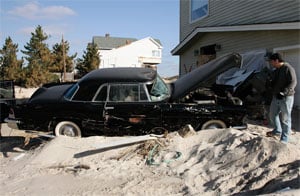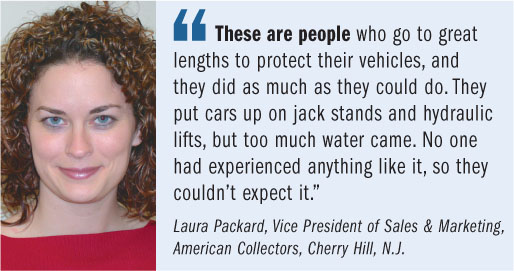 Superstorm Sandy has claimed its share ofproperty and sentimental personal belongings—and in some cases, thedamage left in the storm's wake has been enough to make grown mencry.
Superstorm Sandy has claimed its share ofproperty and sentimental personal belongings—and in some cases, thedamage left in the storm's wake has been enough to make grown mencry.
“Guys come in and they're in tears,” says Kevin J. Mackay, ownerof Corvette Repair Inc. in Valley Stream, N.Y. on Long Island.“They didn't expect a storm surge to wipe out their work, theirinvestment, their prized family heirloom.”
|Mackay, a specialist in Corvettes, says he has 15 flooded carsin his shop.
|When Sandy made landfall in southern New Jersey on Oct. 29, itstruck a concentrated area of car collectors, says Laura Packard,vice president of sales and marketing for American Collectors ofCherry Hill, N.J. New York and New Jersey are two of the company'slarger states for business.
|Several experts say many classic and expensive modern cars arestored right on the coast. Fact is, many owners areaffluent—collecting and/or restoring classic cars is an expensivehobby—and many of them like to live close to water.
|“A lot of business is concentrated [in the Northeast] becausethat's just where [the vehicles are],” says Packard. “There is astrong car-collector culture here.”
|Car owners did the best they could to “fight a losing battle”against the surge, she adds: “These are people who go to greatlengths to protect their vehicles, and they did as much as theycould do. They put cars up on jack stands and hydraulic lifts, buttoo much water came. No one had experienced anything like it, sothey couldn't expect it.”
|The stories are heartbreaking, say agents, restorers andinsurance executives, and now collectors are fighting a battleagainst salt—racing against corrosion. Salt water is among a car'sworst enemies: Every gauge, headlight, leather seat andcarburetor—every sought-after, hard-to-find mechanical part andtrim—is likely trash, ruined by the intruding sea. Mackay saysexhaust pipes are already rotting through.
| And when car owners were lucky enough to avoidthe water, sometimes fallen trees crushed their four-wheeled gems.Packard says one policyholder lifted his two prized Corvettes andavoided the surge, but a tree fell on the garage to claimboth.
And when car owners were lucky enough to avoidthe water, sometimes fallen trees crushed their four-wheeled gems.Packard says one policyholder lifted his two prized Corvettes andavoided the surge, but a tree fell on the garage to claimboth.
The overall result is the “single most devastating loss tocollector cars ever,” declares McKeel Hagerty, CEO of HagertyInsurance Agency, a leading provider of classic-vehicleinsurance.
|SENTIMENT, HISTORY OFF THE ROAD
|Hagerty says the agency has 1,000 total losses. He predictsabout 8,000 to 10,000 vehicles—each with its own story and personalconnection—will be taken off the road, totaled, perhaps for good.
|“And they aren't making any more '57 Chevys,” says JeffreyWalker, senior collector and vehicle-insurance specialist forChubb. “Owners have personal attachments to these vehicles, andthey each have a sense that they are charged with owning a piece ofhistory.”
|And within the classic-car niche, a lot of that history ispersonal.
|“One guy brought in a car he bought with money he saved as a16-year-old doing a paper route,” says Phil Brazer, owner ofNetcong Auto Restoration in Landing, N.J. “We have a 1972 PontiacLeMans that belonged to the owner's dad. Another is the car [inwhich] the owner proposed to his wife. There is a deep love forthese cars, and we're doing everything possible we can forthem.”
|Brazer's shop has a few Sandy-damaged cars, and he's expandingto accommodate damaged boats as well. He says the shop is getting alot of calls and even more clicks on its website from classic-carand boat owners he assumes are looking for repairs.
|“I don't think we've come close to seeing what's coming [in]from this storm,” Brazer says. “Adjusters are overwhelmed, and youhave to figure they understandably have other priorities. Peopleare without homes.”
|Shop manager Hal Haley handles the insurance aspect forcustomers and says insurers have thus far been “very cooperative”despite being so bogged down.
|Walker says policyholders should at least start the drying-outprocess and wash the entire vehicle, outside and under the hood, toget the salt off. Drain every fluid in the car. Carefully removeevery part that may still be salvageable.
|BIG ISSUE: OBJECTIVE VS. SUBJECTIVEVALUE
|The claims process, says Hagerty, involves assessing two sets ofvalues: objective and subjective.
|There are multiple scenarios for these insureds: payment forrepairs, payment for a “total,” payment for some of the total withthe owner buying back the salvage. It's not as simple a decision astotaling a surge-submerged Hyundai.
|These vehicles are personified; they're “like family,” saysHagerty.
| Owners can take the payout from a totaled car(these are agreed-value policies), or they can take a portion ofthe payout to basically buy back the salvage—to likely take thevehicle down to its frame and build it back up again.
Owners can take the payout from a totaled car(these are agreed-value policies), or they can take a portion ofthe payout to basically buy back the salvage—to likely take thevehicle down to its frame and build it back up again.
“It's happening already,” says Brazer. “Some of these guys aregoing to spend more money than the car is worth to restore itbecause it has such sentimental value.”
|Hagerty says his agency has been working with claimants to findtowing or storage and is already working with its network of partssuppliers and car clubs to find replacement pieces.
|Chubb gives policyholders the control of choosing a body shop ortowing carrier, says Walker: “The customer is in the driver's seat.We want to do what is best for them, and we'll work with themthrough the process to try and come to the bestoutcome.”
|Indeed, the process of handling classic-car claims is differentbecause more personal attention is given, agents say. AmericanCollectors, for example, called each policyholder personally.
|“There's a lot of thinking going on right now,” explains Mackay,the Corvette specialist. “We look at the damage. We look at theinsurance payout. We look at the parts and labor—maybe how manycorners we can cut to make it work and get [the car] back on theroad. It's so much work. In some cases it's a complete rebuildbecause of the salt.”
|But “all hope is not lost,” says Walker. After all, theclassic-car community is used to restoring rusted-out cars found inbarns and fields and junkyards. Older cars don't have the computerelectronics of a newer vehicle. The bodies of Corvettes arefiberglass, so they, at least, won't corrode.
|FOR SOME, AN INEVITABLE REBOUND
|Hagerty says about 50 percent of car owners are choosing tosalvage their vehicles.
|“They will absolutely come back,” Packard says of the Northeastclassic-car community. “It may take some time to do that, but thisis a resilient, close-knit group.”
|Hagerty says the superstorm will have a “long-ranging effect” onthe classic-car world. “People will be talking about Sandy formany, many years,” he adds, because so many cars are going to carrythe “Flooded in Sandy” label.
|It's unknown whether a restored classic car that's been throughSandy will hold its pre-storm value, or whether it might be wortheven more because it likely went through a completerebuild.
|“Take pictures and keep receipts,” says Haley of Netcong Auto.“If you sell, I'm guessing buyers will want a lot of proof becauseit's easier to track cars these days. They'll know it was inSandy.”
|Conveying a feeling shared by the insurance industry, Packard ofAmerican Collectors says it will be back to insure the vehicles inthe Northeast.
|“You have to think this a freak accident that hopefully will nothappen again,” says Packard. “And if so, people learn. They'll knowwhat to do next time.”
Want to continue reading?
Become a Free PropertyCasualty360 Digital Reader
Your access to unlimited PropertyCasualty360 content isn’t changing.
Once you are an ALM digital member, you’ll receive:
- All PropertyCasualty360.com news coverage, best practices, and in-depth analysis.
- Educational webcasts, resources from industry leaders, and informative newsletters.
- Other award-winning websites including BenefitsPRO.com and ThinkAdvisor.com.
Already have an account? Sign In
© 2024 ALM Global, LLC, All Rights Reserved. Request academic re-use from www.copyright.com. All other uses, submit a request to [email protected]. For more information visit Asset & Logo Licensing.








